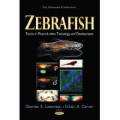Accolades
"Zebrafish: Topics in Reproduction, Toxicology and Development"
by Charles Lessman
Summary
 This informative new volume on the reproduction and development of zebrafish provides
a timely and fundamental set of chapters presenting new data and critical reviews
to the novice student and veteran researcher alike. It covers two major areas of zebrafish
biology, reproduction and development, with toxicology emphasized in a number of chapters.
Historically, reproductive biology of zebrafish has not been given the attention afforded
the more intensively studied aspects of embryonic development in this model species.
In part this may be due to fewer tools available to zebrafish reproductive biologists;
however, with the advent of transparent juvenile and adult lines, new areas of reproduction
research become visible both figuratively and literally. Two chapters are devoted
to presenting these exciting new fish lines and examples of their use in research
to the reproductive biology research community. Reproduction and embryonic development
are a continuum and this is emphasized in a new review on RNA-binding proteins in
the zebrafish oocyte. It is increasingly clear that embryonic development is dependent
upon factors present in the female gamete known collectively as "maternal effects"
and these oocyte components are beautifully summarized in this chapter. Other chapters
cover normal spawning periodicity and vitellogenic oocyte growth dynamics that should
interest ovarian physiologists and those interested in zebrafish husbandry.
This informative new volume on the reproduction and development of zebrafish provides
a timely and fundamental set of chapters presenting new data and critical reviews
to the novice student and veteran researcher alike. It covers two major areas of zebrafish
biology, reproduction and development, with toxicology emphasized in a number of chapters.
Historically, reproductive biology of zebrafish has not been given the attention afforded
the more intensively studied aspects of embryonic development in this model species.
In part this may be due to fewer tools available to zebrafish reproductive biologists;
however, with the advent of transparent juvenile and adult lines, new areas of reproduction
research become visible both figuratively and literally. Two chapters are devoted
to presenting these exciting new fish lines and examples of their use in research
to the reproductive biology research community. Reproduction and embryonic development
are a continuum and this is emphasized in a new review on RNA-binding proteins in
the zebrafish oocyte. It is increasingly clear that embryonic development is dependent
upon factors present in the female gamete known collectively as "maternal effects"
and these oocyte components are beautifully summarized in this chapter. Other chapters
cover normal spawning periodicity and vitellogenic oocyte growth dynamics that should
interest ovarian physiologists and those interested in zebrafish husbandry.Further sections of this book describe experiments centered on zebrafish development. One section focuses on experiments involving the protein localization of the Sodium-potassium-chloride cotransporter (Slc12a2) during zebrafish embryogenesis and has an emphasis on myogenesis. Another section introduces the zebrafish dead elvis (del) mutant. This section highlights experiments involving whole-mount immunohistochemistry experiments describing the muscle defects as well as the positional cloning and complementation analysis indicating that dead elvis carries a mutation of the Titina gene. The advantage of using the zebrafish as a basic model for kidney development research is comprehensively reviewed. This section considers technology available for use in zebrafish including; morpholinos, CRISPR-Cas, and TALENs. These are discussed with regard to better understanding nephrogenesis in zebrafish.
Another overarching topic presented in several chapters of this book highlights the zebrafish as a model vertebrate for toxicological screening and understanding exposure rates during reproduction, development and throughout life. Basic procedures for toxicant testing are discussed in relationship to organogenesis and extended beyond establishing a simple lethal concentration dose for the organism. Another chapter appraised three different assays and their usage to screen for toxicant-induced behavioral defects using zebrafish. Specific sections within this book emphasize research and the current understanding of lead neurotoxicity. Also, a standard test procedure is introduced using zebrafish to better understand gene expression changes in response to pesticide exposures. Overall, these chapters discuss procedures, assays, and different mechanisms that environmental toxicants use to influence development and behavior.
Collectively, this book provides an overview of reproductive pathways, basic development, and toxicological screening focused on using zebrafish as a premier model organism for these processes.
Ethan A. Carver, Ph.D. Charles A. Lessman, Ph.D.
The Editors February 7, 2014 Tennessee, USA
